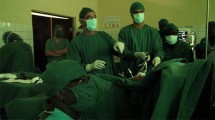Abstract
Introduction
Rectourinary fistulas (RUFs) represent a challenging clinical problem. Most RUFs are secondary to lower urinary or intestinal tract surgery. Several surgical approaches have been proposed. The aim of this study was to review a 15-year experience using the York-Mason posterior sagittal transrectal approach to iatrogenic RUFs.
Methods
Seven patients with RUFs secondary to urologic surgery were operated on with the York-Mason technique at the Department of Urology, University of Padova, Italy between 1988 and 2003. The patients’ data have been collected and analyzed retrospectively.
Results
All the patients were treated successfully (100%). In one patient with Crohn’s disease the fistula recurred 11 years after the first surgery. One patient died for metastasis of prostate cancer 1 year after surgical repair of the RUF. A temporary colostomy was performed in five patients; the colostomies were subsequently closed, and the patients regained complete fecal continence with no postoperative anal strictures. The colostomy remained in place in one patient with Crohn’s disease and in another with ulcerative rectocolitis.
Conclusions
The posterior sagittal transrectal approach provided easy access and identification of RUFs and good surgical exposure, with no subsequent strictures or fecal incontinence. Our data show that the York-Mason technique alone is a highly effective option for treating an iatrogenic postoperative RUF.





Similar content being viewed by others
References
Pandey MB, Sonawalla FP, Trivedi VD. Recto-vesical fistula (report of an usual case). J Postgrad Med 1987;33:149–151
Pesce F, Righetti R, Rubilotta E, et al. Vesico-crural and vesicorectal fistulas 13 years after radiotherapy for prostate cancer. J Urol 2002;168:2118–2119
Norby B, Frimodt-Moller PC. Development of a urethrorectal fistula after transurethral microwave thermotherapy for benign prostatic hyperplasia. BJU Int 2000; 85:554–556
Moss RL, Ryan JA. Management of enterovesical fistula. J Urol 1941; 61:790–793
Munoz M, Nelson H, Harrington J. Management of acquired rectourinary fistulas: outcome according to cause. Dis Colon Rectum 1998;41:514–517
McLaren R, Barrett DM, Zincke H. Rectal injury occurring at radical retropubic prostatectomy for prostate cancer: etiology and treatment. Urology 1993;42:401–405
Leandri P, Rossignol G, Gautier JR, et al. Radical retropubic prostatectomy: morbidity and quality of life; experience with 620 consecutive cases. J Urol 1992;147:883–885
Smith AM, Veenema RJ. Management of rectal injury and rectourethral fistulas following radical retropubic prostatectomy. J Urol 1972;108:778–781
Harpster LE, Rommel FM, Sieber PR, et al. The incidence and management of rectal injury associated with radical prostatectomy in a community based urology practice. J Urol 1995;154:1435–1438
Culp OS, Calhoon HW. A variety of rectourinary fistulas: experience with 20 cases. J Urol 1964;91:560
Goodwin WE, Turner RD, Winter CC. Rectourinary fistula: principles of management and a technique of surgical closure. J Urol 1958;80:246–254
Vose SN. A technique for the repair of recto-urethral fistula. J Urol 1949;61:790
Kilpatrick FR, Thompson HR. Postoperative rectoprostatic fistula and closure by Kraske’s approach. Br J Urol 1962;34:470–474
Trippitelli A, Barbagli G, Lenzi R, et al. Surgical treatment of rectourethral fistulae. Eur Urol 1985;11:388–391
Wilhelm SF. Rectourinary fistula. Surg Gynecol Obstet 1944;79:427–432
Turner-Worwick R. The use of pedicle grafts in the repair of urinary tract fistulae. Br J Urol 1972;44:644
Kilpatric FR, York-Mason A. Post-operative rectoprostatic fistula. Br J Urol 1969;41:649–654
Al-Ali M, Kashmoula D, Saound IJ. Experience with 30 posttraumatic rectourethral fistulas: presentation of posterior transsphincteric anterior rectal wall advancement. J Urol 1997;158:421–424
Pieretti RV, Pieretti-Vanmarcke RV. Combined abdominal and posterior sagittal transrectal approach for the repair of rectourinary fistula resulting from a shotgun wound. Urology 1995;46:254–256
Pena A, De Viries PA. Posterior sagittal anorectoplasty: important technical considerations and new applications. J Pediatr Surg 1982;17:196–199
Rossi F, De Castro R, Ceccarelli PL, et al. Anterior sagittal transanorectal approach to the posterior uretra in the pediatric age group. J Urol 1998;160:1173–1177
Fengler SA, Abcarian H. The York-Mason approach to repair iatrogenic rectourinary fistulae. Am J Surg 1997;172:213–217
Renschler TD, Middleton RG. 30 Years of experience with York-Mason repair of rectourinary fistulas. J Urol 2003;170:1222–1225
Prasad ML, Nelson R, Hambrick E, et al. York-Mason procedure for repair of postoperative rectoprostatic urethral fistula. Dis Colon Rectum 1983;26:716–720
Henderson DH, Middelton RG, Dahl DS. Single stage repair of rectourinary fistula. J Urol 1981;125:592–593
Antony J. A method of repair of recurrent recto-vesico-prostatic fistula following prostatectomy. J Urol 1980;124:936–937
Boushey RP, McLeod RS, Cohen Z. Surgical management of acquires rectourethral fistula, emphasizing the posterior approach. Can J Surg 1998;41:241–244
Venable DD. Modification of the anterior perineal transanorectal approach for complicated prostatic urethrorectal fistula repair. J Urol 1989;142:381–384
Gecelter L. Transanorectal approach to the posterior urethra and bladder neck. J Urol 1973;109:1011
Bukowski TP, Chakrabarty A, Powell IJ, et al. Acquired rectourethral fistula: methods of repair. J Urol 1995;153:730–733
Stephenson RA, Middleton RG. Repair of rectourinary fistulas using a posterior sagittal transanal transrectal (modified York-Mason) approach: an update. J Urol 1996;155:1989–1991
Acknowledgment
The authors thank Mrs. Mirna Segato, PhD, for her assistance with the imaging and the original hand drawings.
Author information
Authors and Affiliations
Corresponding author
Rights and permissions
About this article
Cite this article
Moro, F.D., Mancini, M., Pinto, F. et al. Successful Repair of Iatrogenic Rectourinary Fistulas Using the Posterior Sagittal Transrectal Approach (York-Mason): 15-Year Experience. World J. Surg. 30, 107–113 (2006). https://doi.org/10.1007/s00268-005-7940-8
Published:
Issue Date:
DOI: https://doi.org/10.1007/s00268-005-7940-8




